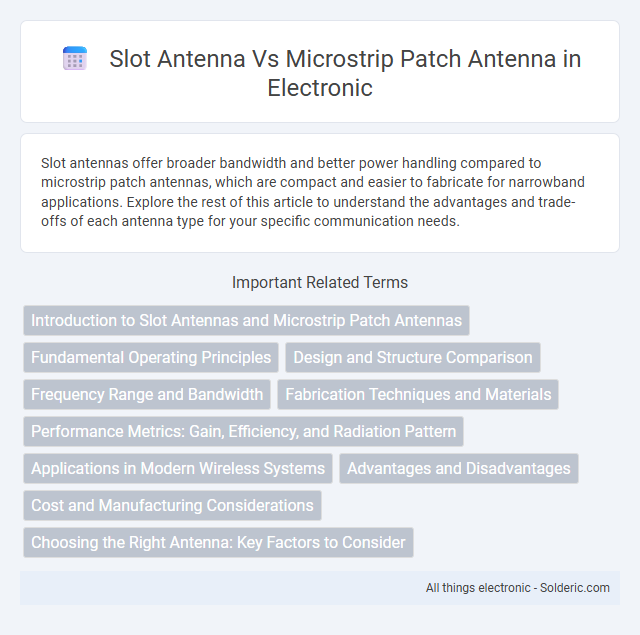Slot antennas offer broader bandwidth and better power handling compared to microstrip patch antennas, which are compact and easier to fabricate for narrowband applications. Explore the rest of this article to understand the advantages and trade-offs of each antenna type for your specific communication needs.
Comparison Table
| Feature | Slot Antenna | Microstrip Patch Antenna |
|---|---|---|
| Structure | Metallic surface with a slot cut out | Conductive patch on dielectric substrate |
| Radiation Pattern | Broadside and directional | Broadside, less directional |
| Polarization | Linear, can be circular with slot design | Linear, easily circular with patch design |
| Bandwidth | Moderate to wide | Narrow to moderate |
| Gain | Moderate (5-10 dBi) | Low to moderate (3-9 dBi) |
| Size | Compact for given frequency | Compact, planar |
| Fabrication | Simple etching on metal sheet | Requires substrate and patch etching |
| Applications | Radar, wireless systems, compact arrays | Wireless communications, GPS, mobile devices |
| Efficiency | High efficiency due to metallic ground plane | Moderate efficiency due to dielectric losses |
Introduction to Slot Antennas and Microstrip Patch Antennas
Slot antennas consist of a metal surface with an etched slot that radiates electromagnetic waves when excited, offering broad bandwidth and simple integration with waveguides. Microstrip patch antennas feature a flat metal patch on a dielectric substrate above a ground plane, providing low-profile, lightweight designs commonly used in wireless communication. Your choice depends on factors like frequency range, radiation pattern, and fabrication constraints.
Fundamental Operating Principles
Slot antennas operate based on the principle of slot resonance, where electromagnetic waves are radiated through a narrow slot cut in a conductive surface, effectively acting as a magnetic dipole. Microstrip patch antennas function by exciting a resonant mode on a dielectric substrate with a metallic patch that radiates electromagnetic energy primarily through fringing fields at its edges. Understanding these fundamental operating principles helps you choose the right antenna type for specific applications requiring compact size, directional radiation, or ease of fabrication.
Design and Structure Comparison
Slot antennas feature a metallic surface with a cut-out slot acting as the radiating element, providing a compact and planar structure suitable for high-frequency applications. Microstrip patch antennas consist of a conductive patch on a dielectric substrate above a ground plane, allowing easy integration with printed circuit boards and offering low-profile designs. Your choice between these depends on space constraints and desired radiation characteristics, with slot antennas typically excelling in wideband and polarization diversity, while microstrip patches offer simpler fabrication and versatile shape options.
Frequency Range and Bandwidth
Slot antennas typically operate in the ultrahigh frequency (UHF) to microwave frequency ranges, offering wide bandwidths that can reach several gigahertz depending on slot dimensions and design. Microstrip patch antennas are generally suited for frequencies from around 300 MHz to tens of GHz but are inherently narrowband, with bandwidths often limited to a few percent of the center frequency. Advances in substrate materials and antenna design techniques, such as stacked patches or using thick substrates, are employed to enhance the bandwidth of microstrip patch antennas.
Fabrication Techniques and Materials
Slot antennas typically utilize metal sheets or ground planes with precise slot cuts created through etching, laser cutting, or milling processes on conductive substrates like copper or aluminum. Microstrip patch antennas are commonly fabricated using printed circuit board (PCB) technology, where copper patches are etched on dielectric substrates such as FR4, Rogers, or Taconic materials, offering high precision and compatibility with large-scale manufacturing. Both antennas demand controlled substrate thickness and dielectric constant to optimize performance, but microstrip patch antennas benefit from standard PCB fabrication methods facilitating cost-effective mass production.
Performance Metrics: Gain, Efficiency, and Radiation Pattern
Slot antennas typically offer moderate gain and efficiency with a radiation pattern that is often directional, making them suitable for applications requiring focused beams. Microstrip patch antennas provide moderate gain and efficiency but excel in compact, planar designs with flexible radiation patterns, including broadside and omnidirectional options. Your choice between these antennas depends on specific performance needs like gain, efficiency, and desired radiation pattern for your wireless communication system.
Applications in Modern Wireless Systems
Slot antennas excel in radar, satellite communication, and RFID systems due to their wide bandwidth and high power handling capabilities. Microstrip patch antennas are widely used in mobile phones, GPS devices, and Wi-Fi routers for their compact size, ease of integration, and low-profile design. Your choice depends on application requirements such as frequency range, radiation pattern, and device form factor in modern wireless systems.
Advantages and Disadvantages
Slot antennas offer high bandwidth and robust performance in harsh environments but are typically larger and more complex to fabricate compared to microstrip patch antennas. Microstrip patch antennas provide compact size, ease of integration with printed circuits, and cost-effectiveness, though they generally exhibit narrower bandwidth and lower power handling capabilities. Your choice should consider these trade-offs based on the specific application requirements such as size constraints, frequency range, and environmental conditions.
Cost and Manufacturing Considerations
Slot antennas generally offer lower manufacturing costs due to their simpler design and fewer materials required compared to microstrip patch antennas. Microstrip patch antennas, however, involve precise fabrication processes like photolithography on dielectric substrates, which can increase production expenses. Your choice between the two should consider budget constraints and the complexity of the intended manufacturing techniques.
Choosing the Right Antenna: Key Factors to Consider
When choosing between slot antennas and microstrip patch antennas, key factors include bandwidth, radiation pattern, and fabrication complexity. Slot antennas typically offer wider bandwidth and are suitable for applications requiring robust performance in harsh environments, while microstrip patch antennas provide compact size and ease of integration with printed circuit boards. Consider the specific application frequency, polarization requirements, and environmental conditions to determine the optimal antenna type.
slot antenna vs microstrip patch antenna Infographic

 solderic.com
solderic.com